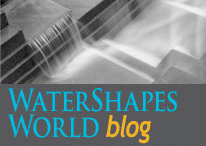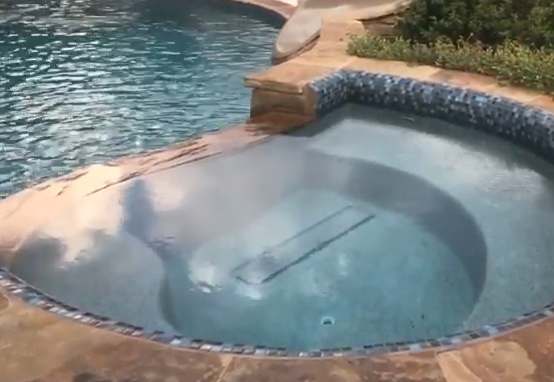ARTICLES
Advance Search
Aquatic Health
Aquatic Health, Fitness & Safety
Around the Internet
Aquatic Culture
Aquatic Technology
Artful Endeavors
Celebrity Corner
Life Aquatic
Must-See Watershapes
People with Cameras
Watershapes in the Headlines
Art/Architectural History
Book & Media Reviews
Commentaries, Interviews & Profiles
Concrete Science
Environment
Fountains
Geotechnical
Join the Dialogue
Landscape, Plants, Hardscape & Decks
Lighter Side
Ripples
Test Your Knowledge
The Aquatic Quiz
Other Waterfeatures (from birdbaths to lakes)
Outdoor Living, Fire Features, Amenities & Lighting
Plants
Ponds, Streams & Waterfalls
Pools & Spas
Professional Watershaping
Structures (Editor's Notes)
Travelogues & History
Water Chemistry
WaterShapes TV
WaterShapes World Blog
Web Links
Around the Internet
Aquatic Culture
Aquatic Technology
Artful Endeavors
Celebrity Corner
Life Aquatic
Must-See Watershapes
People with Cameras
Watershapes in the Headlines
It's happened before: I'll write one of these blogs or a Travelogue, and within a few minutes of releasing the newsletter a reader will send me something that either adds to, explains or (rarely, thank goodness) contradicts something I've written. Back in December, for instance, I wrote about the
‘It seems that everyone’s talking about “sustainability” these days, with the usual thought being that, as exterior designers, good environmental stewardship must be one of our main missions.’ That’s the way Bruce Zaretsky opened his On the Level column five years ago before asking a string of key questions: ‘But what is sustainability? What do watershapers need to do to encompass this philosophy? As important, what does it mean to our clients, and where are
Wrapping up his series on a comprehensive approach to healthier pool water, John Cohen goes into great detail in defining system components and making specific product recommendations.
They say a picture is worth a thousand words. In the case of this project, that old truism was right on the mark. From the start, what my clients seemed to want most was to look at every image I could muster and ask questions and make comments about each one. And it worked: Through their words and body language during these sessions, they offered me almost all of the information I had to have to deliver precisely what they wanted. And that was great, because when I
For the past ten years or so, high-end designers and builders have focused extensively on hiding things that disrupt a viewer's visual pleasure or violate the clean lines and sleek surfaces they've lavished on their watershapes. This may be why you see so few diving boards and slides these days. It may also be a contributing factor in the speed
The three most recent editions of WaterShapes have carried trailblazing articles by John Cohen on his quest to define and develop a toxin-free approach to swimming pool and spa water. I offered no comment when the series started, basically because the articles had to stand straight and tall on their own - but also because
Tireless in his quest for information about and approaches to the creation of toxin-free pools and spas, John Cohen has spent years weighing observations of nature and the human body and figuring out ways to use what he's learned to help people swim in pure, clean, safe water.
These days, using LED lights to illuminate rectangular or kidney-shaped pools is pretty simple: You just space the fixtures out at proper intervals on a wall facing away from prime viewing spots inside the house and on deck, specify the appropriate wattage, hook them up to a suitable control system and step back to bask in the warm nighttime glow. But that sense of routine quickly disappears when
One of the most fascinating college courses I ever took was on the history of science and technology. It focused entirely on Europe, which was limiting. But as I discovered almost immediately, there was so much cool stuff to cover that broadening the content would have turned an already brisk survey into no more than a shallow collection of dates and places.
The ten-week curriculum was divided into ten categories, and the one that has stuck with me most was a three-lecture series on water. It started with the Roman aqueducts and the rise of the concept of taming wild water for the benefit of urban populations, then moved on to the development of dams, reservoirs and organized irrigation systems. The third lecture was about bringing all of that engineering around to displays of power - which, for the most part, was about the use of water in fountains.
The third lecture's key example of applied technology had to do with the Machine de Marly, an attempt by 17th-century engineers to deliver enough water to run all of the fountains and waterfeatures installed at Louis XIV's Palace of Versailles outside Paris.
It turned out that the water program for the grounds far exceeded the capacity of local supplies to feed all of the jets, cascades, basins and waterways with functional head pressure. Stories have it that groundskeepers had to be constantly apprised of the king's location so that any vista he might observe would be fully operational while all other systems were turned off to produce the required pressure. Even at minimal levels, it was virtually impossible to keep everything flowing at once.
Enter Arnold de Ville, who adapted - on a grand scale - technology he'd seen at another French castle, working up a system of 14 water wheels, each 38 feet in diameter, to power 250 pumps that were to lift water more than 500 feet from the River Seine to an aqueduct purpose-built to speed water on its way to Versailles.
But the new availability of water didn't really help: Instead of using it to drive existing fountains at Versailles, the ingenious supply system was used largely to develop new gardens at the nearby Chateau de Marly, another royal estate where Louis XIV spent his time while the palace at Versailles was under construction. But even had the entire flow been delivered to Versailles, the sad fact is that it would still have been wholly inadequate to the purpose: Water rationing remained a constant limitation on the grandeur to which the king aspired.
The Machine de Marly is long gone and in fact lasted only 130 years after its debut in 1684 - a term of service in which the only constant was apparently the need to address breakdowns. Modern pumps finally replaced steam engines and assorted other approaches only in 1968.
As far as I know, the only visible signs of the original system are some reservoir walls along an old roadway between the river and the palace, so this is unique among subjects of these Travelogues in that I'll make no pitch for you to seek anything out. Versailles, of course, is worth a long day's visit, but there's no need to scour the woods looking for systems and structures of a long-gone hydrological wonder.
Whatever its shortcomings, the Machine de Marly was a singularly ambitious approach to what seemed at the time a solvable technological challenge. As our teacher expressed it to us back in 1975, the system's essential failure is less important than the fact that, in its time and place, it could be visualized and attempted - and raised the hydro-engineering bar to a level that hadn't been seen in Europe in more than 1,000 years.
There's also the fact that it allowed the architects at Versailles to carry on as though water supply was not going to be an issue. As a result, the watergardens and fountains are among the most unbridled expressions of centralized administrative power in world history. I'm no monarchist, but I do like the fact that watershapers were the ones who made so much grandeur possible.





















Stepping Up